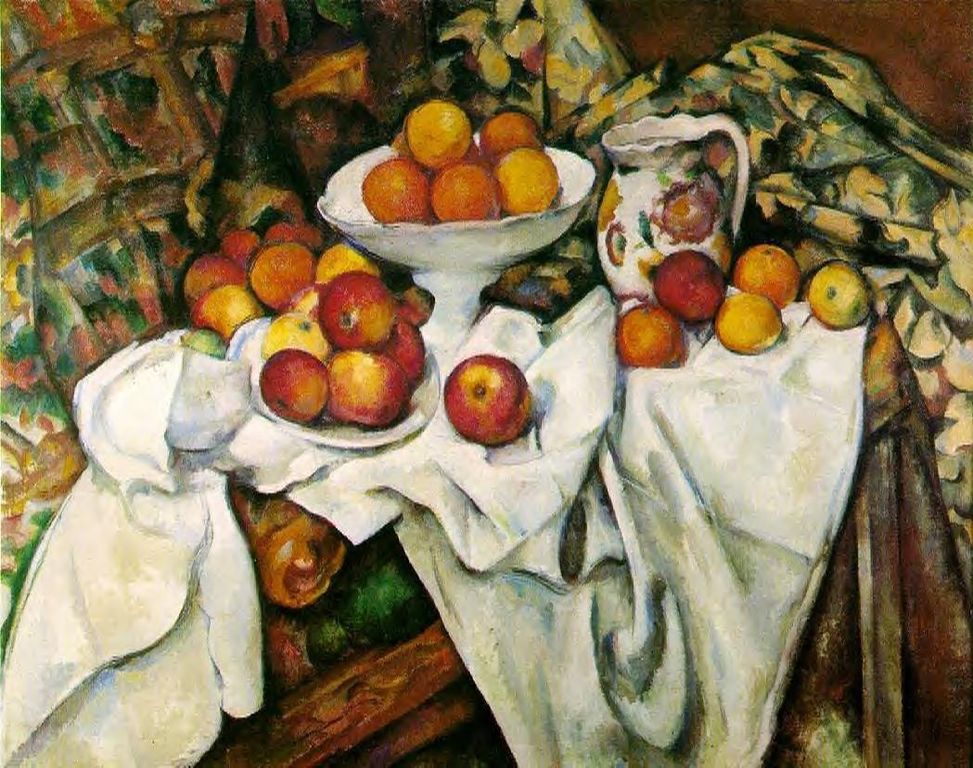
Food as art
Can food be a great work of art?
Can food be art? If so, why? What is art, and can food be great art?
The content of a work of art is what the art is about. With representational art, this is what the artwork depicts. Food can certainly be the content of art. The caption picture above is Cézanne (1839-1906)'s painting Apples and Oranges.
In addition, food can also be the medium of art, as the material that a work of art is made of. Famous German installation artist Joseph Beuys has made use of material such as fat and potatoes in his work.
The next video is about Rirkrit Tiravanija's installation art "Untitled (Free/Still)". The work is a venue where people come in and eat curry and rice. The participants interact with the work of art and become part of it.
Food as a genre of art
A genre of art is a particular category of artwork, eg. dance, sculpture, painting, poem, music, installation art, etc. There can be sub-divisions within a genre, such as symphony, sonata, concerto within classical music.
When food is incorporated in art, it often appears as part of a more general genre of art. For example, egg yolk is an ingredient of tempara paint for paintings. Tiravanija serves curry to visitors who comes to see his work, but the work is a work of installation art, not just a dish of curry. Installation art in general of course does not have to use food.
So this raises the question of whether food can itself be a genre of art on its own. Is that possible? Why or why not?
When you dine at an expensive gourmet restaurant, the experience is very much like visiting a museum or going to a concert. You expect to be entertained and surprised, and to enjoy the experience. Does the food you eat become a work of art in these situations?
Catalan chef Ferran Adrià is one of the most influential cooks in the world today. He is famous for his ''deconstructivist'' molecular cuisineused, using special techniques to reinvent different dishes. In 2007, he was invited to join the famous modern art exhibition Documenta. This is a famous series of art exhibitions, and Documenta 1 included artists such as Picasso, Miro, Henry Moore, Matisse, Klee.
Here is a short movie about Adrià's former restaurant El Bulli:
Food as great art?
Most people believe that food can be a form of art. But there is still a question about the artistic value of food. Is it comparable to other forms of art?
Some have argued that food is a lesser art because food is easily perishable. When we enjoy food we are destroying it, and the period of contemplation is short. So it cannot be shared by lots of people over a long period of time. This is different from a beautiful painting such as the Mona Lisa that can be shown to millions of people.
But is this a legitimate criticism? A valuable musical performance might also last for a short time only. There is also no reason why the same dish cannot be served to lots and lots of people. Surely whether something has artistic merit does not depend on how long it lasts? A great painting that is quickly destroyed can still be a great painting.
Others have suggested that food lacks structure and complexity. A painting or a piece of music has different parts and lots of variations. This makes it fun and interesting to appreciate them.
But how do we compare structure and complexity? Tastes of food can be quite subtle. A meal can have a progressin of courses with layers of taste and smell. Also, is complexity necessary for artistic value? John Cage's 4'33'' is a piece of conceptual art that is recognized as an important work in modern music, but there is no structure to speak of:
The final criticism of food as art is that food does not engage our emotions the way great works of art can. Great art can induce awe-inspiring emotions. A good novel or poem can make us feel sad, angry, nostalgic, excited, fearful, etc. The emotions associated with food are far more limited.
One reason for the difference is that food is limited in what it can represent. Music, pictures, words can portray people and situations in all kinds of ways, both positive and negative. There is symbolism in food of course, but again very limited compared with the major forms of art. Consider the ideas behind Picasso's famous and powerful painting Guernica:
Can food achieve the same kind of depth and intensity when it comes to relating ideas and emotions? Or does food suffer from some inherent limitations as a genre of art?